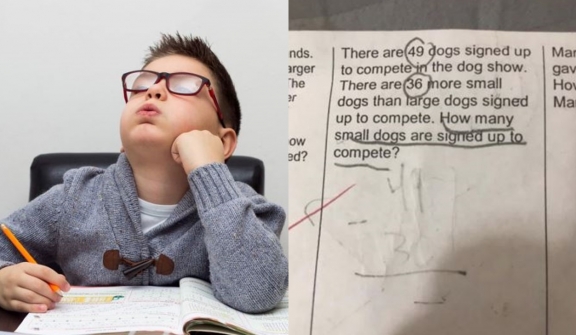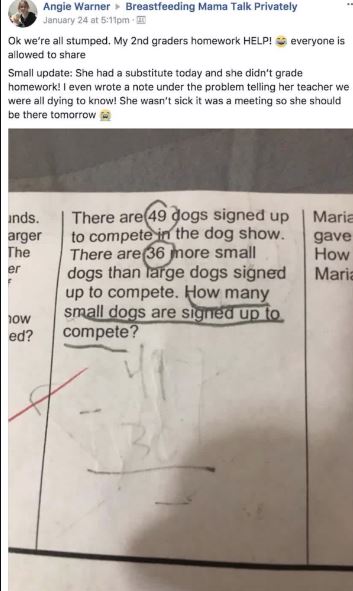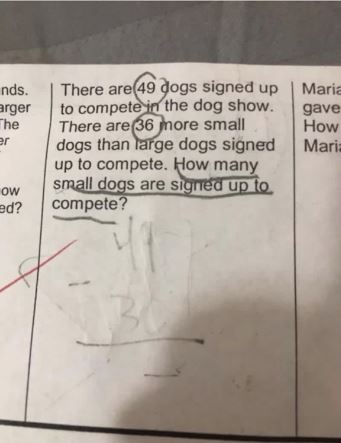
Homework has always been a significant part of the educational journey, eliciting a mix of excitement and anxiety among students. However, it is not as easy as many believe.
This perplexing 2nd-grade math homework was shared by Angie Warner, leaving adults baffled by its complexities.

This math problem left parents and teachers baffled—can you solve it?
On social media, Angie Warner's memory about her second-grader's math homework and her own kindergarten days was shared on Facebook, leaving many baffled.

What was once a symbol of growing up has now become a source of perplexity for her child and many others. Facing a challenging math problem, Angie posted her 2nd grader's math homework on the Breastfeeding Mama Talk Privately Facebook page to seek the answer.
The 2nd Grader's math homework: “There are 49 dogs signed up to compete in the dog show. There are 36 more small dogs than large dogs signed up to compete. How many small dogs are signed up to compete?”
The post quickly went viral and sparked debate on social media.

One person said: Half of 13 is 6 1/2… so 42 1/2 … … small dogs… and 6 1/2 large ones…
A second wrote: I mean, we will have to cut a dog in half. 6.5 big dogs and 42.5 small dogs. I mean WOWWWWWW
While a third commented: The exact answer is 42.5 small dogs and 6.5 big dogs. So to check 42.5-6.5=36. But there are actually 42 small dogs and 6 big dogs realistically speaking, lets just hope the other one signed up but did not show up.
Someone else said: It says 36 MORE. If it werent for those 36, it would be an even number. Or thats what this equation is. But there cant be 6.5 dogs. So its not functional in reality. But its supposed to be 49-36=x. X÷2= answer as there are only 2 categories of dogs mentioned.

Another added: The answer can't be 36 because that means there are 0 large dogs, which make 36 dogs in total. It says "36 MORE small dogs than large dogs", therefore the number of small dogs = large dogs + 36.
At first glance, the problem seemed straightforward. Many assumed the answer was simply 36 small dogs, but the reality was far more complex. The seemingly simple question unraveled into a complicated puzzle, stumping both seasoned mathematicians and everyday parents.
In the comment section, the answer was revealed thanks to the involvement of the school district. The answer, though unconventional, was precise: 6.5 large dogs and 42.5 small dogs. Here’s the algebraic breakdown of the solution:

Let ( x) represent the number of large dogs and ( y) represent the number of small dogs.
According to the problem: [ 49 = x + y] [ y = x + 36 ]3. Substitute ( y ) in the first equation: [ 49 = x + (x + 36) ]
Simplify and solve for ( x): [ 49 = 2x + 36] [13 = 2x] [ x = 6.5 ]
Calculate ( y ): [ y = x + 36 = 6.5 + 36 = 42.5 ]
While the idea of fractional dogs may seem absurd, it illustrates the importance of precise mathematical methods in solving problems.

This is not the first time a math question has left adults perplexed. Another notable instance involves a question asking for the closest time to midnight, which stumped many:
“What is the closest time to midnight? A. 11:55 am, B. 12:06 am, C. 11:50 am, D. 12:03 am.”
The confusion arose because some options were close to midday, not midnight. Here is the correct answer to the question: "What is the closest time to midnight?"




